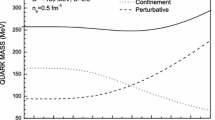Abstract
The three-flavor Skyrme-'t Hooft-Witten model is interpreted in terms of a quark-like substructure, leading to a new model of explicitly confined color-free “quarks” reminiscent of Gell-Mann's original pre-color quarks, but with unexpected and significant differences.
Similar content being viewed by others
References
G. 't Hooft: Nucl. Phys. B72, 461 (1974); ibid. G. 't Hooft: Nucl. Phys. B75, 461 (1974)
E. Witten: Nucl. Phys. B223, 422 (1983); ibid. E. Witten: Nucl. Phys. 223, 433 (1983)
T.H.R. Skyrme: Proc. Roy. Soc. London A260, 127 (1961), and Nucl. Phys. 31, 556 (1962)
A.V. Manohar: Nucl. Phys. B248, 19 (1984)
M.P. Mattis, E. Braaten: Phys. Rev. D39, 2737 (1989)
M. Gell-Mann: Phys. Lett. 8, 214 (1964)
L.C. Biedenharn, Y. Dothan: “Monopolar Harmonics inSU(3) f as Eigenstates of the Skyrme-Witten Model for Baryons”,From SU(3)to Gravity (Ne'eman Festschrift) (Cambridge University Press, Cambridge, England) 19 (1986)
L.C. Biedenharn, A. Giovannini, J.D. Louck: Math. Phys. 8, 691 (1967)
L.C. Biedenharn, J.D. Louck: “Angular Momentum in Quantum Physics:” Cambridge University Press, (Cambridge, U.K.) (1981)
M. Anselmino, E. Predazzi, S. Ekelin, S. Fredriksson, D.B. Lichtenberg: Rev. Mod. Phys. 65, 1199 (1993)
Witten had good reason to call this new parameter “the number of colors”. He showed that the anomaly implied an electromagnetic interaction which, to agree with experiment, forced the anomaly parameterN W to be 3, the physical number of colors. But we insist that Witten's anomaly parameter,N W , is logically distinct from the parameter (N ′ =∞) used in defining theSU(3)/U1 manifold itself
L.C. Biedenharn, E.C. Fowler: Nuovo Cim. 33, 1329 (1964)
Note the amusing point: Gell-Mann chose the label “color” by analogy to physical color, which has abasis of three colors. Gell-Mann's analogy is even more apt in our case, whereN ′ →∞ corresponds to the infinite number of colors (distinct wave-lengths) while the number ofbasis colors being three, corresponds to themodulus N W
Using the same procedure for three-flavors as used by Manohar [4]—— and by Mattis-Braaten [5] for two flavors
L.C. Biedenharn, L.P. Horwitz: “On the Equivalence of the Skyrme-Witten and Large-N c Quark Models”, to be published in Foundations of Physics
Author information
Authors and Affiliations
Rights and permissions
About this article
Cite this article
Biedenharn, L.C., Horwitz, L.P. Quarks in the Skyrme-'t Hooft-Witten model. Z. Phys. C - Particles and Fields 65, 551–553 (1995). https://doi.org/10.1007/BF01556143
Received:
Issue Date:
DOI: https://doi.org/10.1007/BF01556143




